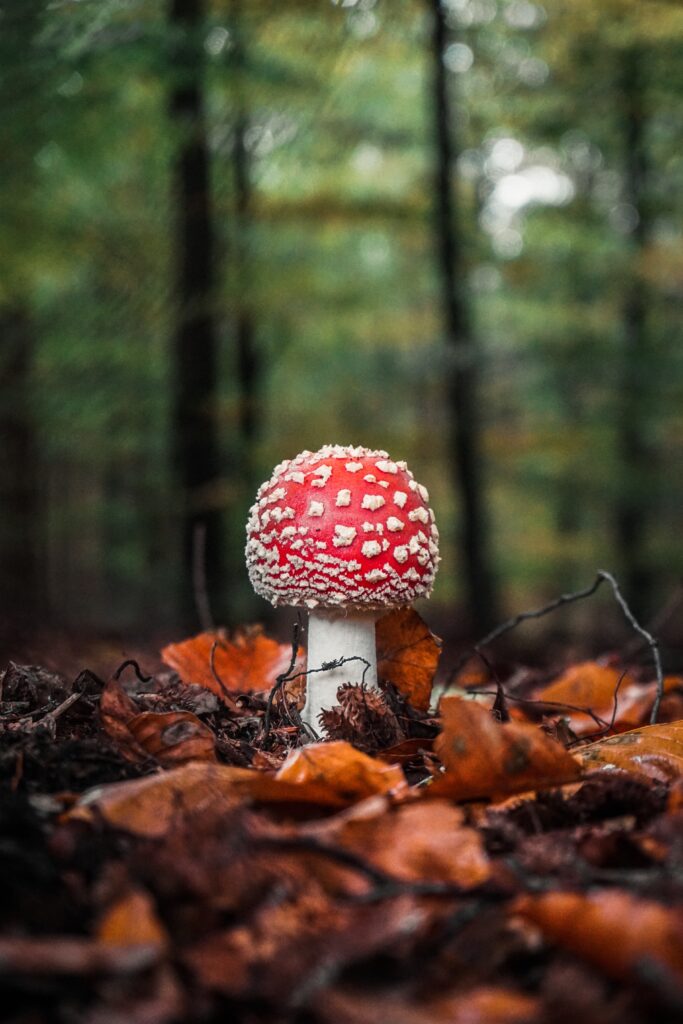Learn more about the fungi growing around you with this outdoorsy Gainesville group.
Written By Melissa Peterson
Mushrooms—they’re all around us, especially this time of year during Florida’s rainy season. Whether you notice them while hiking through the woods or simply lounging in your backyard, these fantastic fungi can be intricate and colorful, small or unbelievably large.
Classified as neither a plant nor an animal, fungi make up their own kingdom, and the fleshy mushroom that is usually found sprouting above the ground or on its food source is actually the fruiting body of a fungus.

If you’re curious about mushrooms you’ve seen and want to learn more, the Florida Academic Lichen And Fungi Enthusiasts League (FALAFEL) is the perfect place to start. Started in 2017 by Sarah Prentice, this Gainesville group aims to get more people out into nature with mycology experts to learn about our area’s wild fungi in a safe and informative environment.
“Currently, we have about 4,500 followers on our Facebook page,” says Logan Borosch, an aspiring mycologist and the current president of FALAFEL. “The group is open to anyone. There are no entry or walk fees, and people can join us by following our page on Facebook and joining our groups ‘FALAFEL Talk’ or ‘FALAFEL – North Florida Chapter.’”
The group offers guided walks called Mushroom Meanderings, usually led by Logan or other experts. The walks typically take place at the Natural Area Teaching Lab in Gainesville, but they occasionally partner up with other parks or owners of private property. The types of mushrooms commonly found on the walks vary with the seasons, as most mushrooms do have specific phenologies, or seasons.
“Mushrooms can be found almost anywhere,” says Logan. “Many mushrooms are saprobic, meaning they break down dying materials such as compost, fallen trees or mulch, making them common to find in gardens or the woods. Florida lawns are also always filled with mushrooms.”
If you do find a mushroom in your yard and are curious about IDing it, Logan suggests posting to the Facebook group “Florida Mushroom & Fungus ID.” The group has many expert identifiers from all over the world, guaranteeing fast and accurate identifications.
“Make sure to include photos of the cap, stem and underside,” suggests Logan, “and carefully excavate the base from beneath the dirt, as it is very important for identification for many trickier mushrooms. Removing a mushroom from its growth place does not harm the overall fungus or prevent it from growing again. Mushrooms are solely reproductive fruiting bodies formed by mycelium in its substrate. Similar to picking an apple from a tree, you’re not killing the tree, only taking some fruit.”
While on one of the Mushroom Meandering walks, the group leaders always mention to watch for snakes and other wildlife or potentially toxic plants growing nearby, because, contrary to popular belief, these dangers will cause more harm than handling a mushroom.
“Mushrooms cannot deal harm from just handling, even barehanded and with deadly species, as mycotoxins need to be ingested to deal any harm to the body,” says Logan. “Our group does provide education on toxic and edible species on walks, as well as how to handle wild mushrooms.”
Logan attributes the spike in the public’s interest in mushrooms to the Covid pandemic.
“People were going on more hikes during the pandemic to get outside,” he says. “They noticed more mushrooms than they had before. I personally enjoy mushrooms and mushroom hunting because it is an underrated branch of science, meaning there is so much to learn and discover. I hope more people join us on our walks to learn a little more about the world around them.”
Florida Academic Lichen And Fungi Enthusiasts League
Check out the group’s Facebook page at facebook.com/FLmycology for upcoming Mushroom Meandering dates.
